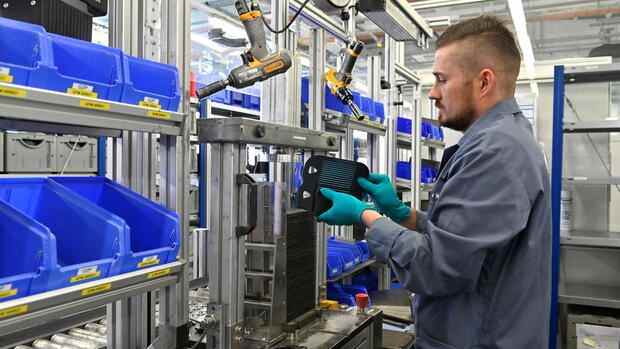Production of hydrogen electrolysers is now to pick up speed at two more locations in Germany.
(Photo: REUTERS)
Dusseldorf The hydrogen start-up Sunfire from Dresden is expanding production in Germany. With the takeover of the metal specialist MTV and its production facilities in Solingen and Mülheim (Ruhr), the planned giga factory is now set to pick up speed. The company is one of the experts for the functional surface coating of large components and will in future produce important components for Sunfire’s electrolyser production in Dresden.
“It usually takes several years to build up such capacities, but we have accelerated this with the takeover,” says Sunfire CEO Nils Aldag in an interview with the Handelsblatt. In the coming months, the systems are to be converted and modernized accordingly. This is how the hydrogen start-up wants to achieve its goal of putting the first electrolyser factory in Germany with a capacity of 500 megawatts into operation by 2023. After that, an expansion to one gigawatt per year is planned.
At the end of last year, Sunfire collected another 109 million euros for its project. The financiers include investors Lightrock, Planet First Partners (PFP) and Carbon Direct Capital Management.
There is only one problem: the young company still lacks orders. “Discussions with customers are going very well, also on a significant scale. But we are still struggling with the fact that we are not an industry giant,” admits Aldag.
Top jobs of the day
Find the best jobs now and
be notified by email.
The so-called “Power-to-X” technology for the production of green hydrogen should gain in importance in the next few years, but as of now there are only pilot projects – even if the first major cooperations have already been announced. All experts agree that the demand for hydrogen will soon rise sharply.
Because green hydrogen is an important building block for the success of the energy transition. Electrolysis capacities in the European Union are expected to multiply from the current 1,000 megawatts to 40,000 megawatts by 2030. Above all, this requires the expansion of renewable energies such as wind and sun, from which green hydrogen can then be produced.
High demand in industry and shipping
In the electricity-based electrolysis process, water is broken down into its components oxygen and hydrogen with the help of electricity. If green electricity is used for the electrolysis, the end product is correspondingly green. Experts currently see the greatest need in industry, shipping and aviation. Wherever the use of a battery is more expensive or difficult to implement.
Industry giants such as Siemens Energy, Linde and Air Liquide have now recognized the coming billion-euro market and are massively expanding their electrolysis production. Thyssen-Krupp recently announced that it would list its electrolysis division on the stock exchange under the name Nucera. The order backlog for green hydrogen was already around 900 million euros at the end of December 2021. Sales are expected to triple by 2026.
In view of the weighty competition, it might be a challenge for a newcomer like Sunfire to keep up with the competition. Unlike its competitors, the company has not yet received a single major order. The announced giga factory should change that. “Sunfire is in a good price position and we have proof of production capacity. With the new production facility, we therefore hope to land the first major orders this year.”
More: Thyssen-Krupp expects up to 600 million euros in income from the hydrogen IPO.

